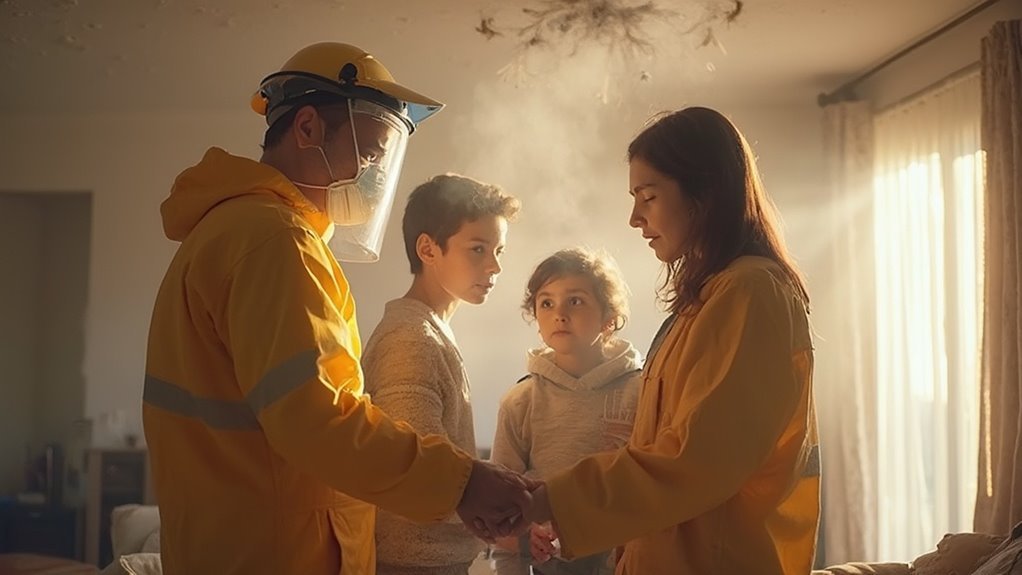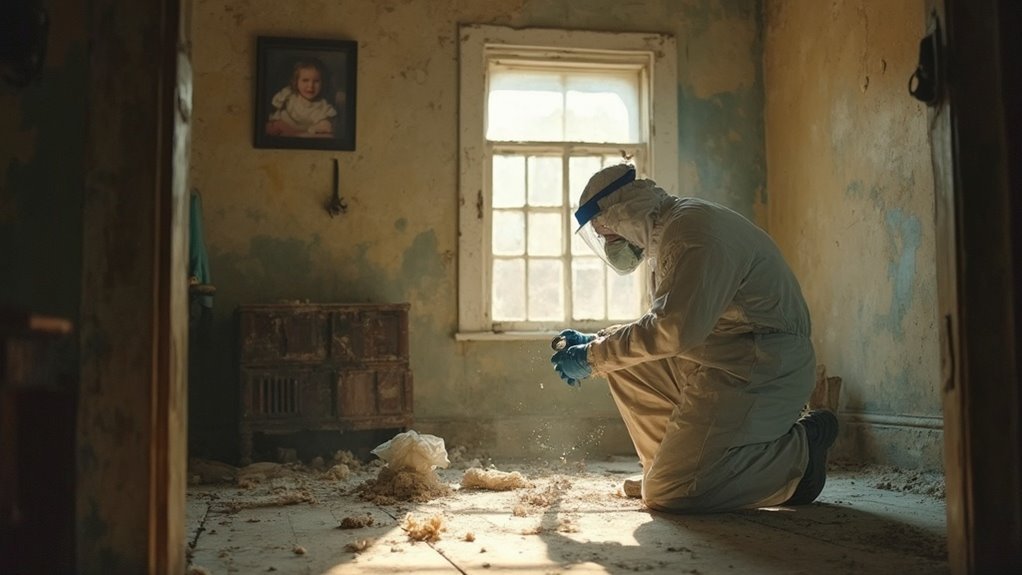Asbestos inspections are crucial for safeguarding your family from serious health risks. These evaluations identify hidden asbestos-containing materials (ACMs) in your home, which may release harmful fibers when disturbed. Chronic exposure can lead to severe conditions like asbestosis, lung cancer, and mesothelioma. Regular inspections by certified professionals help detect potential hazards early, ensuring compliance with safety regulations and minimizing exposure risks. Moreover, timely assessments protect vulnerable family members, especially children, from secondary exposure. By understanding the inspection process, you can take proactive steps to maintain a safe living environment and greatly reduce health threats associated with asbestos.
Understanding Asbestos Hazards

When it comes to understanding asbestos hazards, it's vital to recognize the various sources of exposure that can pose significant health risks. Asbestos materials are commonly found in older buildings, and during construction or demolition activities, fiber release can occur if these materials aren't handled properly. Vehicle maintenance, especially brake and clutch repairs, can likewise introduce asbestos fibers into the air. Mining and manufacturing processes often disturb asbestos, leading to significant fiber release. Furthermore, asbestos can contaminate air, water, and soil, posing long-term health risks even far from the original source. Over time, asbestos materials can deteriorate, releasing hazardous fibers into the environment. Proper testing is essential for identifying and managing these risks effectively.
It's imperative to remember that no level of asbestos exposure is considered safe. Chronic exposure, even to low amounts of asbestos fibers, can result in serious diseases such as asbestosis, mesothelioma, and lung cancer. Inhaled asbestos fibers can remain in the lungs for a long time, leading to cumulative health issues. Given the global impact of asbestos exposure, with over 200,000 deaths annually linked to work-related cancers, understanding these hazards becomes vital for protecting yourself and your family.
Recognizing Asbestos-Related Diseases
Recognizing asbestos-related diseases is fundamental for early intervention and effective management. As you become aware of the symptoms, you'll be in a better position to act decisively. These diseases often develop gradually, making symptom recognition critical for timely diagnosis and treatment.
| Symptom | Associated Condition | Disease Progression |
|---|---|---|
| Chest pain | Asbestosis | Early stage |
| Crackling sounds | Asbestosis | Progressing respiratory issue |
| Persistent cough | Lung cancer | Advanced stage |
| Shortness of breath | Mesothelioma | Chronic condition |
| Clubbed fingertips | Severe asbestosis | Late-stage complication |
Symptoms like chest tightness, crackling sounds in the lungs, and persistent cough should raise red flags. As you monitor these indicators, be aware that the risk of developing serious conditions increases with prolonged exposure. Misdiagnosis can occur, given the overlap with other respiratory illnesses. Consequently, it's vital to consult a healthcare professional if you experience any of these symptoms. Early detection can greatly influence disease progression and improve outcomes. Additionally, understanding asbestos-related regulations is essential for managing exposure risks effectively.
Occupational and Secondary Exposure Risks

When you work in high-risk occupations, the potential for asbestos exposure increases markedly, putting your health at serious risk. Furthermore, your family members may unknowingly face exposure through contaminated clothing or personal items, raising concerns about their safety. It's essential to understand how both occupational and secondary exposure can impact not only your health but likewise that of your loved ones, especially children who may be more vulnerable to these risks.
Occupational Health Risks
Asbestos exposure poses significant health risks, particularly in occupational settings where workers frequently handle asbestos-containing materials. Jobs such as construction, shipbuilding, and vehicle maintenance often expose you to dangerous levels of asbestos. Firefighters, while responding to emergencies, can likewise face significant exposure. The health risks associated with occupational exposure are severe, including mesothelioma, lung cancer, and asbestosis. There's no safe level of exposure, and even short-term contact can lead to long-lasting health issues.
Health regulations aim to protect workers from these dangers, but enforcement can vary. In spite of legal measures taken by many countries to ban asbestos, it still exists in various forms within industries. Preventive measures such as using protective gear during maintenance and ensuring safe handling protocols are essential in reducing risks.
Moreover, registries of exposed workers and medical surveillance can provide early diagnosis and treatment for asbestos-related diseases. The impact of asbestos exposure is significant, with hundreds of thousands affected globally. Understanding these occupational health risks is imperative for both workers and their families, as it can help drive safer practices and compliance with health regulations.
Family Exposure Concerns
Occupational health risks extend beyond the workplace, greatly impacting families of those who work with asbestos. Secondary exposure is a major concern, as it occurs when workers inadvertently bring toxic asbestos fibers home on their clothing, skin, or hair. This exposure can happen during close interactions, such as hugs or a child sitting on a parent's lap. If you handle or wash contaminated clothing in your home, you further increase the risk of exposing your family to these harmful fibers.
It's vital to maintain exposure awareness, as secondary asbestos exposure can lead to severe health issues, including mesothelioma, lung cancer, and asbestosis. About 90% of mesothelioma cases stem from asbestos exposure, highlighting the serious risks involved. Family safety should be a priority, particularly for those living with individuals who work directly with asbestos materials.
To mitigate risks, wash contaminated clothing separately and use protective gear when handling asbestos materials. Regular inspections of your home for signs of asbestos wear or damage are important. By understanding and addressing these exposure concerns, you can greatly reduce health risks for your family.
Children's Vulnerability Factors
Children are particularly vulnerable to both occupational and secondary exposure to asbestos due to their developing bodies and unique behaviors. Their smaller lung size and higher surface area to volume ratio increase the impact of inhaled asbestos fibers. Furthermore, children breathe faster, which raises inhalation risks, allowing them to take in more asbestos with each breath. Their tendency to put fingers in their mouths can lead to the ingestion of contaminated fibers, further heightening their susceptibility.
Secondary exposure poses significant risks, especially when a parent works in an asbestos-heavy occupation. Workers can unknowingly transfer asbestos fibers home on clothing, skin, or hair, exposing children to hazardous materials. Even brief daily encounters, such as hugging a parent after work or handling their laundry, can lead to serious health implications.
Long-term exposure at a young age increases the likelihood of developing asbestos-related diseases, which can take decades to manifest. Considering that there's no safe level of asbestos exposure, it's essential to understand these vulnerabilities. By recognizing children's susceptibility to asbestos, you can take proactive steps to minimize their risk and safeguard their health.
Importance of Asbestos Inspections
The importance of asbestos inspections cannot be overstated when it comes to safeguarding health and ensuring regulatory compliance. Asbestos has a complex history, having been widely used in construction materials until its health risks became apparent. You must understand that exposure to asbestos can lead to severe illnesses like asbestosis, lung cancer, and mesothelioma. This underlines the necessity of thorough inspection procedures to identify and manage asbestos-containing materials (ACMs) in your environment.
Regular inspections not only help pinpoint the presence of ACMs but likewise assess their condition, guiding effective mitigation actions. Certified inspectors utilize proper sampling and laboratory analysis to determine the concentration of asbestos, ensuring compliance with OSHA and EPA regulations. By conducting these inspections, you protect not only your family's health but likewise fulfill your legal responsibilities, avoiding potential costs and delays in future renovations.
Asbestos inspections ultimately offer peace of mind, ensuring a safe living environment. With the knowledge gained from these inspections, you can make well-informed choices about managing asbestos risks, contributing to a healthier future for you and your family.
Prevention and Safety Measures

To effectively prevent asbestos exposure, you need to adopt safe handling practices and schedule regular inspections of your property. Engaging certified professionals for assessments not only guarantees compliance but additionally improves safety by identifying potential risks early. By being proactive, you can greatly reduce the likelihood of asbestos-related health issues.
Safe Handling Practices
Effective asbestos handling practices are crucial for minimizing health risks associated with exposure. By following these guidelines, you can protect yourself and others while working with asbestos-containing materials.
- Use Wet Methods: Always wet down materials before cutting or breaking to prevent fiber release. Regularly spray surfaces with water and avoid dry cleanup methods like sweeping. Instead, opt for HEPA-filtered vacuums to guarantee thorough cleanup.
- Wear Protective Equipment: Equip yourself with disposable clothing made of synthetic fabric, making sure it fits properly. Use NIOSH-approved respirators (N100 or P100) and coveralls to prevent contamination. Inspect and maintain your protective gear according to the manufacturer's specifications.
- Confirm Safe Disposal: After completing work, double bag all asbestos waste to prevent leakage. Clean the work area immediately using wet methods and HEPA-filtered vacuums. Shower and wash your hair thoroughly to remove any lingering fibers, and dispose of personal protective equipment safely.
Regular Inspections Importance
Regular inspections play an important role in managing asbestos risk and guaranteeing safety in buildings, especially those constructed before the 1990s. These inspections help identify asbestos-containing materials (ACMs) that can be present in insulation, roofing, flooring, and electrical boxes. Aging or damaged ACMs release dangerous asbestos fibers, which pose serious health risks. To accurately detect ACMs, inspections must be conducted by qualified inspectors who understand the complexities of asbestos management.
The frequency of these inspections is significant for ongoing safety. Regular checks not only comply with legal obligations but as well protect the health of occupants and workers. By identifying and managing ACMs effectively, you can prevent exposure and guarantee a safer environment. Implementing preventive measures—like using HEPA filter vacuums and wet cleaning methods—further reduces risks during inspections.
It's important to isolate areas containing ACMs from the rest of the property during inspections to prevent contamination. Ignoring the need for these inspections can lead to significant penalties and put lives at risk. Consequently, prioritizing regular asbestos inspections is a vital step in maintaining a safe living and working space.
Professional Assessment Benefits
Professional assessment of asbestos risks offers numerous benefits that can considerably improve safety and prevent health hazards. By utilizing trained professionals for asbestos testing and thorough risk assessment, you're taking vital steps toward safeguarding your family's health. Here are three key benefits of professional assessment:
- Early Detection: Identifying asbestos-containing materials early prevents exposure, minimizing health risks like lung cancer and asbestosis.
- Safe Handling: Certified inspectors guarantee proper handling and disposal of asbestos, following strict containment procedures to avoid contamination.
- Comprehensive Evaluation: A thorough evaluation identifies all potential asbestos sources, guaranteeing that no material goes unexamined.
Actions for Homeowners
Awareness of asbestos risks is vital for homeowners aiming to maintain a safe living environment. As a homeowner, you bear the responsibility to regularly inspect your property for signs of asbestos-containing materials (ACMs). Conduct visual inspections frequently, checking for wear or damage in insulation, flooring, and roofing. If you suspect the presence of ACMs, hiring a certified asbestos inspector is fundamental for professional evaluation and sample testing.
When you identify materials like crumbling drywall or damaged insulation, it's critical to leave undisturbed ACMs alone if they're in good condition. Limit access to affected areas and avoid disturbing these materials through activities such as drilling or scraping. Should you need to repair or remove ACMs, always engage trained professionals for safe abatement.
Before any renovation or demolition, conduct an asbestos survey to identify potential hazards. This proactive approach not only complies with legal requirements but additionally protects your family's health. By understanding your homeowner responsibilities and adhering to inspection frequency guidelines, you help guarantee a safer living space and mitigate the risks associated with asbestos exposure.
Long-Term Health Benefits

Inspections and proactive management of asbestos risks not only safeguard your home but furthermore play an essential role in long-term health benefits. By regularly monitoring your environment and addressing potential asbestos issues, you greatly improve your family's well-being. Here are three key long-term health benefits:
- Early Detection and Intervention: Regular health monitoring allows for the early identification of asbestos-related diseases. This can lead to better treatment outcomes and improved prognoses.
- Risk Reduction: Proactive asbestos management minimizes exposure to harmful fibers. This reduces the likelihood of developing severe health complications associated with prolonged asbestos exposure, such as lung cancer and mesothelioma.
- Quality of Life Improvement: Continuous monitoring and timely interventions can help you avoid the debilitating effects of asbestos-related diseases, ultimately preserving your quality of life.
Frequently Asked Questions
How Can I Find a Certified Asbestos Inspector?
Finding a certified asbestos inspector isn't like searching for a unicorn. Start by checking state agency listings, ensuring they meet inspection qualifications, and verify their certifications through accredited training providers or local environmental protection agencies.
What Are the Costs Associated With Asbestos Inspections?
Asbestos inspection pricing typically ranges from $200 to $1,000, influenced by your home's size and complexity. Factor in potential removal costs, which can considerably increase your overall expenses if asbestos is found.
How Long Does an Asbestos Inspection Typically Take?
So, you think an asbestos inspection's a quick stroll? Well, it varies! Inspection duration depends on building size and procedures. Small spaces might take hours, while larger ones can need days. Plan accordingly!
What Happens if Asbestos Is Found in My Home?
If asbestos is found in your home, you must prioritize safety. Engage certified professionals for asbestos removal, as exposure poses significant health hazards. Avoid disturbing materials and guarantee proper containment and cleanup to minimize risks.
Are Asbestos Inspections Required by Law in My Area?
Maneuvering local compliance is like steering through a complex maze; asbestos regulations often require inspections before renovation or demolition. Check your area's specific laws to guarantee you're following mandated procedures for safety and compliance.
